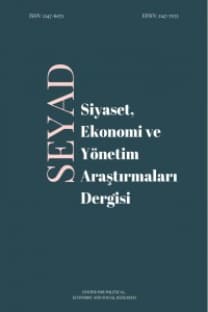Güney Sudan'da iç Savaş ve Önündeki Zorluklar
South Sudan, civil war, peace negotiations, foreign influence, SPLA
Cıvıl War and The Challenges Ahead ın South Sudan
South Sudan, civil war, peace negotiations, foreign influence, SPLA,
___
- Adwok Nyaba, P (2014) South Sudan: The Crisis of Infancy. Cape Town: The Centre for Advanced Studies of African Society.
- Agwaanda, B., Asal U.Y. (2020) State Fragility and Post Conflict State-Building: An analysis of South Sudan Conflict (2013-2019) Istanbul Commerce University.
- Ajak, P., Larson, G. Pritchett, L. (2013) South Sudan’s capability trap: Building a state with disruptive innovation. Centre for International Development at Harvard University.
- Appiah Afriye, F., Jisong, J., Yaw Appiah, K. (2020) Comprehensive analysis of South Sudan conflict: determinants and repercussions. MISC.
- Baker, A., (2016) War crimes: Slaughter and starvation haunt a broken South Sudan, pp. 20-27
- Ballentine, K., Nitzschke, H. (2005). The political economy of civil war and conflict transformation. Berghof Research Centre for Constructive Management, Berlin.
- Bip Inc., (2018) South Sudan Country Study Guide- Strategic Information and Developments (Worlds Business and Investment Library) BIP Inc.
- Blackings, M.J. (2016). Why Peace Fails: The Case of South Sudan’s Agreement on the Resolution of the Conflict in South Sudan. Nairobi.
- Blanchard, L.P. (2016). Conflict in South Sudan and the challenges ahead. Congressional Research Service.
- Bodetti, A. (2019). How China Came and Dominate South Sudan- The Diplomat Publication.
- Caroline, F., Pratheepan, M., Sharif, S., Sokunpanha, Y., (2012). China and the Sudan-South Sudan Oil Fee Impasse, Implications of Chinese Foreign Aid, Diplomacy and Military Relations. Cheeseman, N. (2015). Democracy in Africa: Successes, failures, and the struggle for political reform. Cambridge, Cambridge University Press.
- China’s Foreign Policy Experiment in South Sudan (2017) Asia Report No.288.
- Chol, A., L. (2011) 20 years apology: A political campaign for Dr. Riek Machar-A case of ‘Why Gurang Must Go Now’ is now recanted.
- De Soysa, I. (2002). ‘Paradise is a bazaar? Greed, creed, and governance in civil war, 1989-1999.’ Journal of Peace Research 39, no.4: pp 395- 416.
- De Vries, L., Schomerus, M., (2017). South Sudan’s Civil War will Not End with a Peace Deal, Peace Review. Pp. 333-340.
- Frontier Economics (2015) South Sudan: The Cost of War. In collaboration with the Centre for Conflict Resolution (CECORE) and the Centre for Peace and Development Studies (CPDS).
- Hanzich, R. (2011). Struggles in south Sudan. Harvard International Review, 33, pp 38-41.
- Hodzi, O., (2017) Note d’actualité n°14/16 de l’Observatoire de la Chine, cycle 2016-2017 January.
- Human Rights Watch (2014b) South Sudan: Ethnic Targeting, widespread killings.
- Janssen, J., (2017). South Sudan: Why power-sharing did not lead to political stability. Unpublished M.A. thesis, University of Leiden.
- Jamie, F.O.M., (2017). The Dynamics of National Identity Building in South Sudan.
- Johnson, D. H, (2014). Briefing: The crisis in South Sudan. African Affairs. Pp. 300-309.
- Jok, J.M., (2015). The paradox of peace in Sudan and South Sudan: Why political settlements failed to endure. Inclusive Political Settlements Papers, Berlin, Berghof Foundation.
- Keitany, P. (2016) The African Union Mission in South Sudan: a case study of South Sudan: Unpublished M.A. thesis. The University of Nairobi.
- Kindersley (2017) South Sudan: A political economy analysis. Norwegian Institute of International Affairs (NUPI). Oslo.
- Knopf, L.A. (2016). Ending South Sudan’s civil war. Council Special Report No.77. Council on Foreign Relations; Centre for Preventive Action, New York.
- Nyadera, I.N. (2018) South Sudan conflict from 2013- 2018: Rethinking the causes, situation and solutions. pp. 59-86.
- O’Brien, A. (2009) Shots in the dark: The 2008 South Sudan civilian disarmament campaign. Geneva: Small Arms Survey.
- OCHA. (2014). Annual Report: United Nations Office for Coordination of Humanitarian Affairs.
- Ottaway M, El-Sadany, M (2012), SUDAN: From Conflict to Conflict: Carnegie Endowment for International Peace Publications Department.
- Reuters (2013) South Sudan president says military has foiled coup. Reported in The Guardian.
- Rolandsen, Ø. H., Glomnes, H. M., Manoeli, S., & Nicolaisen, F. (2015). A year of South Sudan’s third civil war. Pp. 87-104.
- Rolandsen, Ø. H. (2015). Small and far between; Peacekeeping economies in South Sudan. Journal of Intervention and state-building.
- Rolandsen Ø.H (2015). Another civil war in South Sudan: the failure of the Guerrilla Government? Journal of Eastern African Studies. Pp. 163-174.
- Sachs, Jeffrey D. and Warner A. M. (2001). The curse of natural resources. European Economic Review, pp. 827-838.
- Sefa-Nyarko, C. (2016) Civil war in South Sudan: Is it a reflection of historical secessionist and natural resource wars in ‘Greater Sudan’? African Security. Pp. 188-210.
- Taulbee, J. L., Kelleher, A., Taulbee, J. L., & Grosvenor, P. C. (2014). Norway's peace policy: Soft power in a turbulent world. London, Palgrave Macmillan.
- UNMISS (2014b) South Sudan: UN chief stresses support for independence and sovereignty. UN News Centre.
- Vertin, Z., (2018) A Poisoned Well: Lessons in Mediation from South Sudan’s Troubled Peace Process. International Peace Institute, New York.
- Warner, L. A. (2016). The disintegration of the Military Integration Process in South Sudan (2006-2013). International Journal of Security and Development, pp. 1-20.
- ISSN: 2147-6071
- Yayın Aralığı: Yılda 2 Sayı
- Başlangıç: 2014
- Yayıncı: Politik Ekonomik ve Sosyal Araştırmalar Merkezi
BİST KATILIM ENDEKSİNİN FIKHİ TARAMA METODOLOJİLERİ ÇERÇEVESİNDE DEĞERLENDİRİLMESİ
Katılım ve Geleneksel Bankalarda Karlılığın Banka Risk Duyarlılıkları Üzerine Olan Etkisinin Analizi
Huzeyfe Zahit ATAN, Resul AYDEMİR
Güney Sudan'da iç Savaş ve Önündeki Zorluklar
SELÇUKLU DEVLETİ KURULUŞ DÖNEMİNDE (1040-1092) TÜRK DEVLET ANLAYIŞINDA PERS ETKİLERİ
